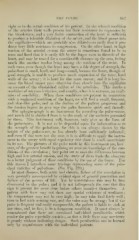Page 657 - My FlipBook
P. 657
THE PULSE. 667 ; ; ;
right as to the actual condition of lii.s patient. In the rehixed condition
of the arteries their walls present but little resistance to expansion by
the blood-wave, and a \'ery feeble contraction of the heart is sufficient
to produce a tolerable dilatation of the artery, and the blood passes into
the capillaries—which are probably also dilated—so easily that it pro-
duces very little resistance to compression. On the other hand, in high
tension of the arterial system the artery is sometimes found to be so
tense and hard that it is easily felt by the finger even in diastole of the
heart, and may be traced for a considerable distance up the arm, feeling
much like another tendon Ivina; amona; the tendons of the wrist. In
such cases, even thougli the heart may have a fair degree of strength, the
pulse-beat is small, hard, and long—small, because the heart, though of
good strength, is unable to produce much expansion of the tense, hard
walls of the artery ; it is hard for the same reason ; and it is long be-
cause the blood cannot pass otherwise than slowly into the capillaries
on account of the diminished calibre of the arterioles. This marks a
condition of nervous irritation, and usually, when it is extreme, an exalt-
ation of sensibility. When these conditions are present in connection
with a w^eakened condition of the heart, we will find a small, frecpient,
and shot-like pulse, and as the decline of the patient progresses and
the tension begins to give way the pulse becomes quick and thready.
The sphygmograph is an instrument for recording the pulse-waves,
and much aid is obtained from it in the study of the varieties presented
by them. This instrument will, however, only give us the form of
the pulse-wave. It is not to be depended upon for information as to
the strength of the pulsations, for this is not always shown by the
height of the pulse- wave, as has already been sufficiently indicated
and even if this were not the case, it is so difficult to apply the instru-
ment to the artery with equal regularity that there is much uncertainty
in its use. The pictures of the jiulse made by this instrument are, hoM'-
ever, of the greatest benefit in gaining an accurate knowledge of the con-
ditions of the circulation ; they point out at once the differences between
high and low arterial tension, and the study of them leads the observer
to a better judgment of these conditions by the use of the finger. For
this reason I introduce some tracings representing some of the prin-
cipal varieties of pulsations. (See Fig. 370.)
In most diseases, both acute and chronic, failure of the circulation is
very generally accompanied by evident signs of general prostration and
failure of the powers of life. Yet by watchfulness this may be first
discovered in the pulse ; and it is not infrequently the case that this
sign is present for some time before others manifest themselves. A
patient with fever may not show any special evidences of weakness
the temperature may not be very high ; he may take food fairly Avell
turn in bed with seeming ease, and the voice may be strong ; but if the
pulse is frequent and easily compressible, the patient is liable to sink at
any time, and, in fact, is in a dangerous condition. It must always be
remembered that there are occasional individual peculiarities which
render the pulse especially sensitive, so that a little fever may accelerate
it greatly without indicating danger. Such peculiarities can be learned
only by acquaintance with the individual patients.


